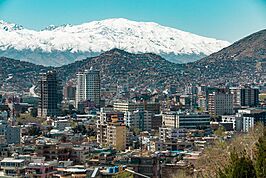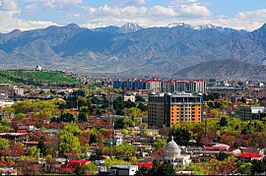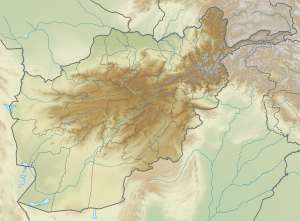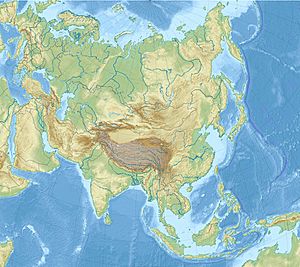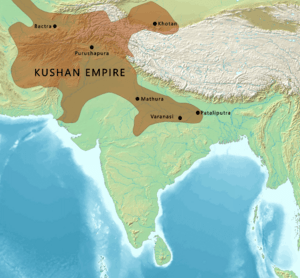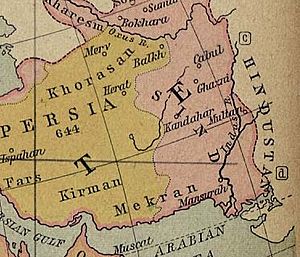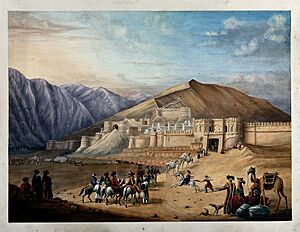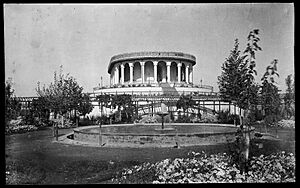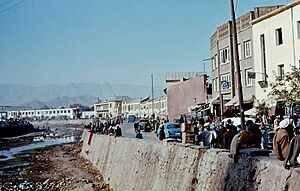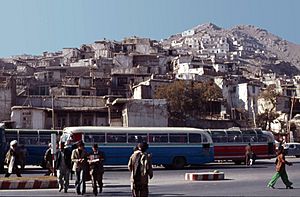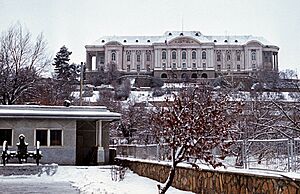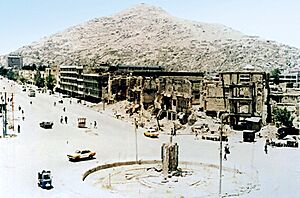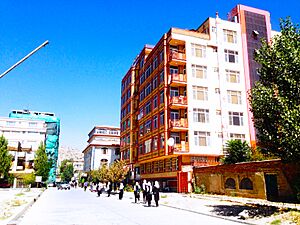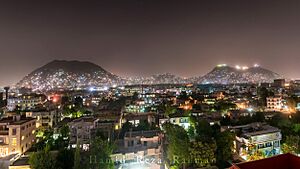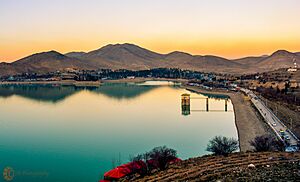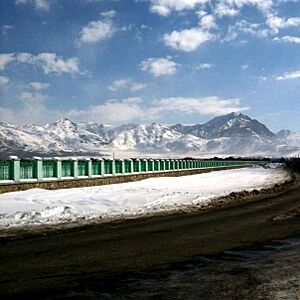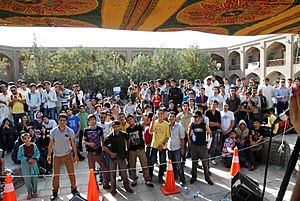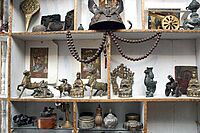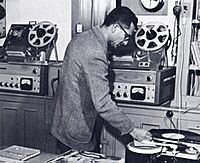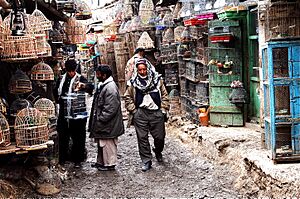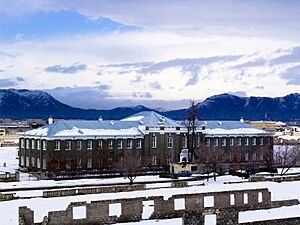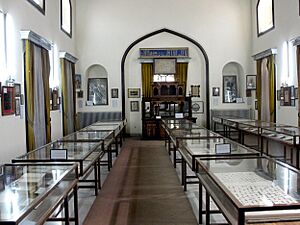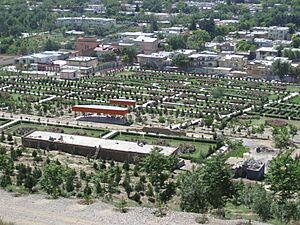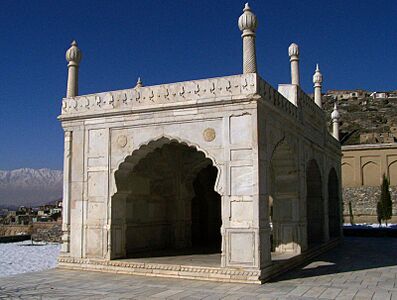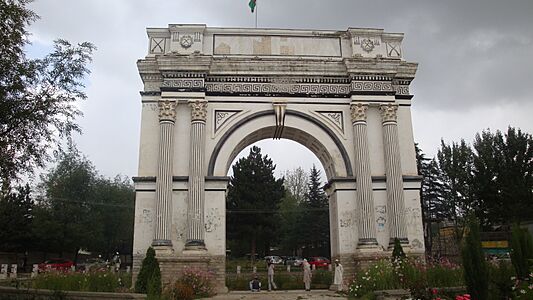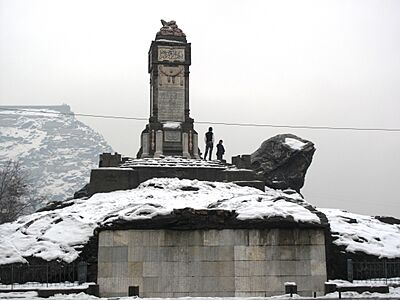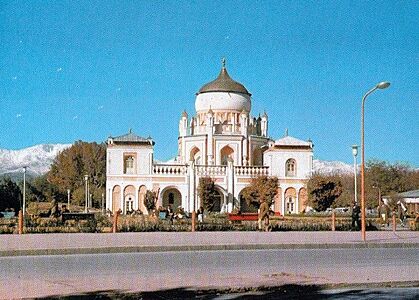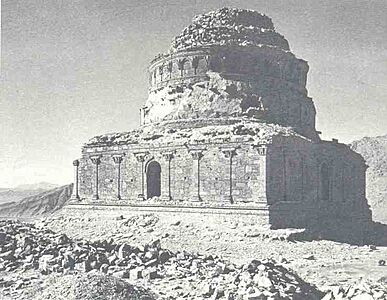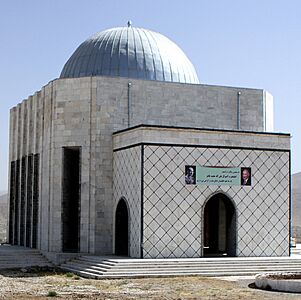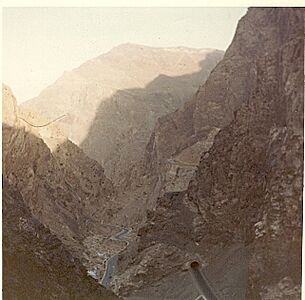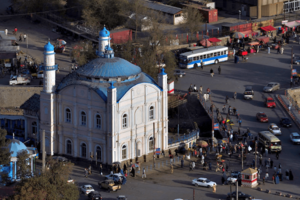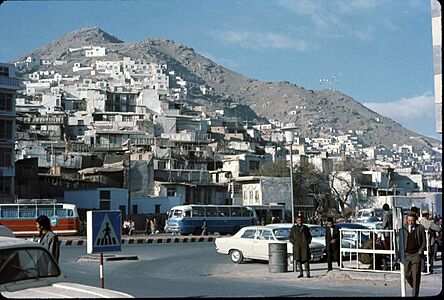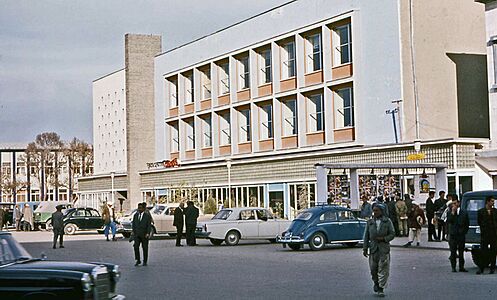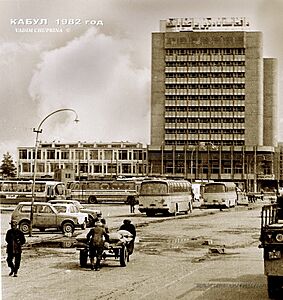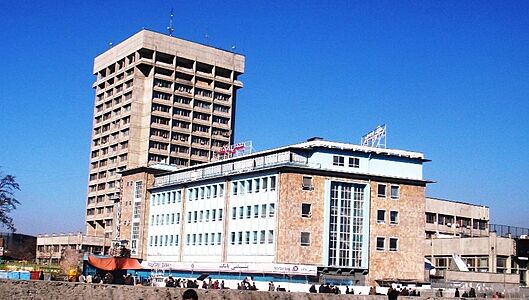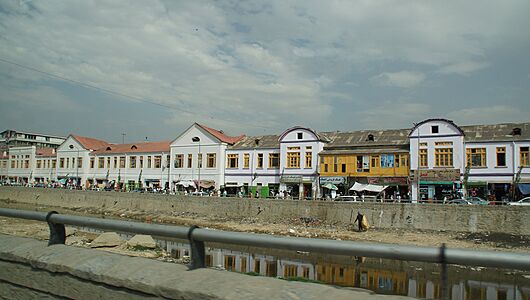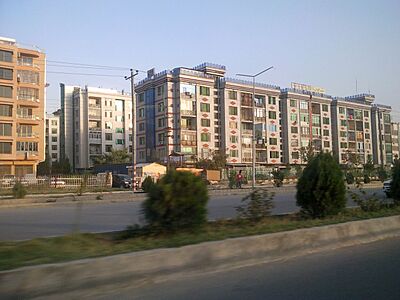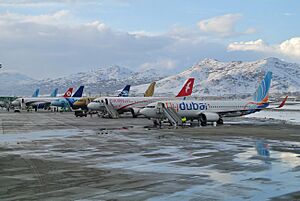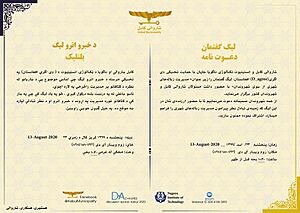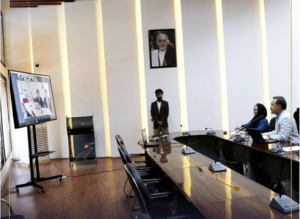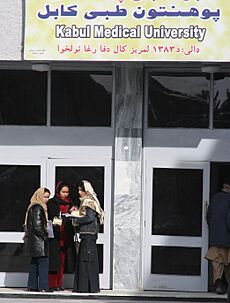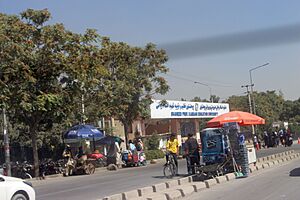Kabul facts for kids
Quick facts for kids
Kabul
کابل
|
||
|---|---|---|
|
Left-to-right from top:
Skyline in 2020, the Arg, Shah-Do Shamshira Mosque, Sakhi Shrine, modern Kabul, skyline in 2021 |
||
|
||
| Nickname(s): | ||
| Country | Afghanistan | |
| Province | Kabul | |
| No. of districts | 22 | |
| No. of Gozars | 630 | |
| Capital formation | 1776 | |
| Government | ||
| • Type | Municipality | |
| Area | ||
| • Total | 1,028.24 km2 (397.01 sq mi) | |
| • Land | 1,028.24 km2 (397.01 sq mi) | |
| • Water | 0 km2 (0 sq mi) | |
| Elevation | 1,791 m (5,876 ft) | |
| Population
(2023)
|
||
| • Total | 4.954 million | |
| • Density | 4,815/km2 (12,470/sq mi) | |
| Demonyms | Kabuli | |
| Time zone | UTC+04:30 (Afghanistan Time) | |
| Postal code |
10XX
|
|
| Area code(s) | (+93) 20 | |
| Climate | BSk | |
Kabul is the capital city of Afghanistan. It is located in the eastern part of the country. Kabul is also a municipality, which means it has its own local government. The city is divided into 22 areas called municipal districts. In 2023, about 4.95 million people lived there.
Kabul is Afghanistan's main center for politics, culture, and business. It has grown very quickly, making it the country's largest city. It is also the 75th-largest city in the world. A well-known school in Kabul is the National Public School.
The city of Kabul sits high in a narrow valley within the Hindu Kush mountains. The Kabul River flows through it. At an elevation of 1,790 meters (5,870 feet), it is one of the highest capital cities in the world. The older parts of the city have historic neighborhoods like Khashti Bridge and Chandavel.
Kabul is believed to be over 3,500 years old. It was mentioned during the time of the ancient Persian Empire. The city is in a key location in Asia, along important trade routes between Central Asia and South Asia. It was a major stop on the ancient Silk Road. Over many centuries, different empires and rulers controlled Kabul. These included the Mauryans, Kushans, and Mughals.
In the 16th century, the Mughal Empire used Kabul as a summer capital. This made the city grow and become more important. In 1776, Kabul became the capital of Afghanistan under Timur Shah Durrani. In the 19th century, the British briefly occupied the city.
Kabul is famous for its beautiful gardens, busy markets (bazaars), and grand palaces. Some examples are the Gardens of Babur, Darul Aman Palace, and the Arg. In the mid-1900s, many Europeans visited Kabul. It earned the nickname "Paris of Central Asia" because of its peaceful and lively atmosphere.
This peaceful time ended in 1978 with a revolution. The Soviet–Afghan War followed in 1979, lasting 10 years. The 1990s saw civil wars that badly damaged much of the city. In 1996, the Taliban took control of Kabul. In 2001, the American-led invasion led to the Taliban losing power. However, in 2021, the Taliban re-occupied Kabul after American and NATO forces left.
Contents
- Understanding the Name of Kabul
- Kabul's Long History
- Kabul's Geography
- Who Lives in Kabul? Demographics
- Sports in Kabul
- Kabul's Economy and Infrastructure
- Culture and Famous Places
- Getting Around Kabul: Transportation
- Learning in Kabul: Education
- Famous People from Kabul
- Sister Cities
- Images for kids
- See also
Understanding the Name of Kabul
Kabul can also be spelled as Cabool, Cabol, Kabol, or Cabul. The exact meaning of the name is not known. However, it was an important place on the trade route between India and the Hellenic world even before Islam arrived.
In ancient Sanskrit, it was called Kubha. Greek writers called it Kophen or Kophes. A Chinese traveler named Xuanzang called it Koafu in the 7th century AD. The name "Kabul" was first used for the Kabul River. Later, it was used for the area between the Hindu Kush mountains and Sindh (now in Pakistan). This area was also known as Kabulistan.
Some legends say that Kabul once had a lake with an "Island of Happiness." A king built a bridge ("pul" in Persian) made of straw ("kah" in Persian) to reach it. This legend suggests the name Kabul came from combining "kah" and "pul."
The city became well-known after Genghis Khan caused destruction in the 13th century. Because of its central location and cultural importance, Kabul was called the "Paris of Central Asia" in the late 20th century.
Kabul's Long History
The exact origins of Kabul are not fully known. Ancient texts like the Hindu Rigveda (from 2000-1500 BC) and the Avesta (a Zoroastrian holy book) mention the Kabul River and a settlement called Kubha.
Ancient Times: Empires and Cultures
The Kabul valley was part of the Median Empire around 678–549 BC. Then, Cyrus the Great took control, and Kabul became part of the Achaemenid Empire. During this time, Kabul was a learning center for Zoroastrianism, Buddhism, and Hinduism. An inscription on Darius the Great's tomb lists Kabul as one of his empire's regions.
When Alexander the Great conquered the Achaemenid Empire, Kabul came under his rule. After his death, it became part of the Seleucid Empire. Later, the Mauryan Empire took control. During the Mauryan period, trade grew, and new irrigation systems helped farming.
The Greco-Bactrian Kingdom and then the Indo-Greek Kingdom ruled Kabul. These rulers supported Buddhism, and most people in the city followed this religion. The Kushan Empire later took over. They were Indo-European people from Bactria.
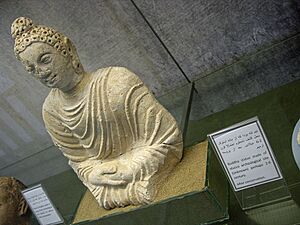
The Chinese monk Xuanzang called the city Kaofu in the 7th century AD. Around 45 AD, the Kushan Emperor Kujula Kadphises conquered Kabul. It remained Kushan territory for about 200 years.
Around 230 AD, the Sassanid Empire defeated the Kushans. The city was then called "Kapul" in Pahlavi scripts. This name means "Royal Bridge" in Persian, referring to a main bridge over the Kabul River. Later, different tribes like the Kidarites and Hephthalites ruled. It became part of the Kabul-Shahan kingdom.
Jewish Community in Kabul
Jews lived in Afghanistan for a very long time, until 2021. Records show Jewish people in Kabul since the 8th century. In the 12th century, an Arab geographer noted a Jewish quarter in Kabul. In the early 1800s, many Jews came to Kabul seeking safety from persecution in Iran.
Generally, Jews were treated well in Afghanistan until the 1870s, when anti-Jewish laws were passed. Things improved under King Nadir Shah, but after his death in 1933, violence against Jews increased. Their communities in Kabul and Herat became like ghettos.
After Israel became a country, the Jewish community asked King Zahir Shah for permission to move there. Afghanistan was the only country that let its Jewish citizens move to Israel without losing their Afghan citizenship. Most of the remaining 2,000 Jews left after the Soviet invasion in 1979.
By 1992, only two Jews were believed to be left in Afghanistan, living in a synagogue in Kabul. The Taliban took their holy Torah scroll during their first rule. Zablon Simintov was thought to be Afghanistan's last Jew for a long time. However, Tova Moradi left months after him in November 2021. She had lived in Kabul for decades and secretly attended synagogue. After her departure, it is believed there are no Jews left in Afghanistan.
Islam Arrives and Mongol Invasion
The Islamic conquest reached Afghanistan in 642 AD. At that time, Kabul was independent. It was seen as part of the Indian world. Early attempts to bring Islam to the region were not always successful. In the late 600s, Abdur Rahman bin Samara converted 12,000 people in Kabul to Islam, but then left the city.
Muslims were a minority until Ya'qub bin Laith as-Saffar conquered Kabul in 870. He established the first Islamic dynasty in the region. An Iranian traveler in 921 described Kabul as having a strong castle with Muslims and a town with non-Muslims from India.
Over the next centuries, different Islamic groups controlled the city. In the 13th century, the Mongols invaded and caused great destruction. Many people fled south to India.
Mughal Empire and Later Dynasties
In the 14th century, Kabul became a major trading center under Timur (Tamerlane). In 1504, Babur took the city and made it his main base. It became one of the most important cities of his later Mughal Empire. Babur loved Kabul and wanted to be buried there. His tomb has a famous Persian poem that says: "If there is a paradise on earth, it is this, and it is this, and it is this!"
Kabul remained under Mughal control for 200 years. It was an important border city for the empire. Under Emperor Akbar, Kabul became the capital of its own Mughal province. The city grew, with new markets and gardens. Its population was about 60,000.
Later, the Mughal Empire lost interest in Kabul. In 1738, Nader Shah captured the city on his way to invade India.
Durrani and Barakzai Dynasties
After Nader Shah's death, Ahmad Shah Durrani established the Afghan Empire in 1747. This marked the start of modern Afghanistan. Kabul had shrunk to a population of 10,000. In 1776, Ahmad Shah's son, Timur Shah Durrani, moved the capital from Kandahar to Kabul.
Kabul grew a lot under Timur Shah and his successor, Zaman Shah. Many religious and public buildings were built. People like Sufis and writers were encouraged to move there. An English traveler in the 18th century called Kabul "the best and cleanest city in Asia."
In 1826, Dost Mohammad Khan took control. In 1839, the British Empire helped Shah Shujah Durrani regain the throne during the First Anglo-Afghan War. A local uprising in 1841 led to the killing of British officials. In 1842, the British returned to Kabul and destroyed the main market before leaving.
The Second Anglo-Afghan War began in 1879. During this war, the Bala Hissar fortress was partly destroyed.
Kabul in the 20th Century
By 1916, Kabul had growing leather and textile industries. Most people lived on the south side of the river.
King Habibullah Khan modernized the city. He brought electricity, telephones, and a postal service. The first modern high school, Habibia, opened in 1903. In 1919, after the Third Anglo-Afghan War, King Amanullah Khan declared Afghanistan's full independence. Amanullah wanted to build a new capital city called Darulaman, which included the famous Darul Aman Palace. Many schools were founded in Kabul in the 1920s.
In 1929, King Amanullah left Kabul after an uprising. Habibullah Kalakani took power briefly. Then, King Nader Khan took over. He was assassinated in Kabul in 1933. His 19-year-old son, Zahir Shah, became the last King of Afghanistan. Unlike Amanullah, Nader Khan and Zahir Shah did not build a new capital, so Kabul remained the center of government.
During the years between the World Wars, France and Germany helped develop Afghanistan. They supported high schools in Kabul, educating children from important families. Kabul University opened in 1932. By the 1960s, many teachers and university instructors had Western education.
Kabul's only railway, the Kabul–Darulaman Tramway, ran from 1923 to 1929. When Zahir Shah became king in 1933, Kabul had few modern services. He sought help from Japan, Germany, and Italy to build transportation and communication networks. Factories for textiles, power, carpets, and furniture were built in Kabul.
In the 1940s and 1950s, Kabul grew rapidly. The city's developed area increased greatly. The Serena Hotel, the first Western-style luxury hotel, opened in 1945. In the 1950s, foreign investment increased. The Soviet Union provided money for public transport, airports, and highways. In the 1960s, Soviet-style housing complexes were built. The Kabul Zoo opened in 1967. During this time, Kabul became more open, allowing more freedom of speech and assembly. This led to student protests by different political groups.
Foreigners came to Kabul as tourism grew. Western-style hotels opened. Tourists visited places like Chicken Street and the National Museum of Afghanistan, which had amazing cultural items. Kabul was called the Paris of Central Asia. An American diplomat described Kabul as a "pleasant city" before 1978, without the large slums seen in other Asian cities.
Until the late 1970s, Kabul was a popular stop on the "Hippie trail" for travelers.
Wars and Changes (1978–2001)

On April 28, 1978, President Daoud was killed in Kabul's Presidential Palace. A pro-Soviet group took power and began making changes. Private businesses were taken over by the government. Education was changed to follow the Soviet model, focusing on Russian language and Soviet ideas.
On December 24, 1979, the Soviet Union invaded Afghanistan. Soviet forces heavily occupied Kabul. The city became their command center during the Soviet–Afghan War. While most fighting was in the countryside, Kabul was also affected. Crime and attacks on government targets were common. Many party members and Soviet troops were kidnapped or killed. A major uprising against the Soviets happened in Kabul in February 1980, leading to a night curfew that lasted seven years.
Kabul's population grew from about 500,000 in 1978 to 1.5 million in 1988. This was mostly due to people fleeing other parts of the country for safety in Kabul. During this time, women made up 40% of the workforce. Soviet civilians were common in the city's shopping areas.
After the government fell in April 1992, different groups entered the city. They formed a government, but one group refused to join and began attacking the city. This started a difficult period for Kabul. At least 30,000 civilians were killed in what locals called the "Kabul Wars." By 1996, about 80% of the city was destroyed. The old city and western areas were hit the hardest.
In late 1994, the attacks on the capital stopped for a while. Efforts were made to bring back law and order. Courts started working again. On September 27, 1996, the Taliban took control of Kabul. They established a strict form of Islamic law. They limited women's work and education.
Kabul in the 21st Century
In November 2001, the Northern Alliance captured Kabul after the Taliban left the city following an American invasion. A month later, a new government began to form under President Hamid Karzai. A NATO-led force was sent to Afghanistan. Many Afghans who had left the country returned. Kabul's population grew from about 500,000 in 2001 to over 3 million. Foreign embassies reopened.
Rebuilding began in 2001. Many damaged landmarks were repaired, like the Gardens of Babur and the Taj Beg Palace. Local communities also helped fix homes. With more people, the city grew quickly, and many informal settlements were built. New, modern housing complexes were built for a growing Afghan middle class.
A high-security "Green Zone" was created in the city center. In 2010, a system of guarded checkpoints called the Ring of Steel was put in place. Concrete walls appeared throughout Kabul for security.
Despite frequent attacks, mainly by Taliban insurgents, Kabul continued to develop. In 2012, it was the fifth fastest-growing city in the world. The Afghan National Security Forces (ANSF) were in charge of security until August 2021. Kabul often faced deadly bombings, mostly by the Taliban.
The city was taken by the Taliban on August 15, 2021. Under Taliban rule, the city and country have seen some peace, though attacks by other groups still happen.
Kabul's Geography
Kabul is in the eastern part of Afghanistan. It sits 1,791 meters (5,876 feet) above sea level in a narrow valley. The Hindu Kush mountains surround it, and the Kabul River flows through it. South of the old city are ancient walls and the Sher Darwaza mountain. Further east is the old Bala Hissar fortress and the Kol-e Hasmat Khan lake.
Kabul is often described as a "bowl surrounded by mountains." Some of these mountains include Khair Khana-e Shamali and Sher Darwaza. There are also hills within the city, like Bibi Mahro. The Logar River flows into Kabul from the south, joining the Kabul River near the city center.
The city covers an area of 1,023 square kilometers (395 sq mi), making it the largest in Afghanistan. Kabul is roughly halfway between Istanbul (in Western Asia) and Hanoi (in Eastern Asia).
Kabul's Climate
Kabul has a continental, cold semi-arid climate. This means it has dry summers and cold winters. Most rain and snow fall in winter and spring. Summers are dry with low humidity. Autumns have warm days and cool nights. Winters are very cold, especially in January, due to the city's high elevation. Spring is the wettest time of year. The sun shines a lot throughout the year.
| Climate data for Kabul (1956–1983) | |||||||||||||
|---|---|---|---|---|---|---|---|---|---|---|---|---|---|
| Month | Jan | Feb | Mar | Apr | May | Jun | Jul | Aug | Sep | Oct | Nov | Dec | Year |
| Record high °C (°F) | 18.8 (65.8) |
18.4 (65.1) |
26.7 (80.1) |
29.4 (84.9) |
33.5 (92.3) |
37.7 (99.9) |
40.5 (104.9) |
41.0 (105.8) |
35.1 (95.2) |
31.6 (88.9) |
24.4 (75.9) |
20.4 (68.7) |
41.0 (105.8) |
| Mean daily maximum °C (°F) | 4.5 (40.1) |
5.5 (41.9) |
12.5 (54.5) |
19.2 (66.6) |
24.4 (75.9) |
30.2 (86.4) |
32.1 (89.8) |
32.0 (89.6) |
28.5 (83.3) |
22.4 (72.3) |
15.0 (59.0) |
8.3 (46.9) |
19.5 (67.1) |
| Daily mean °C (°F) | −2.3 (27.9) |
−0.7 (30.7) |
6.3 (43.3) |
12.8 (55.0) |
17.3 (63.1) |
22.8 (73.0) |
25.0 (77.0) |
24.1 (75.4) |
19.7 (67.5) |
13.1 (55.6) |
5.9 (42.6) |
0.6 (33.1) |
12.1 (53.8) |
| Mean daily minimum °C (°F) | −7.1 (19.2) |
−5.7 (21.7) |
0.7 (33.3) |
6.0 (42.8) |
8.8 (47.8) |
12.4 (54.3) |
15.3 (59.5) |
14.3 (57.7) |
9.4 (48.9) |
3.9 (39.0) |
−1.2 (29.8) |
−4.7 (23.5) |
4.3 (39.7) |
| Record low °C (°F) | −25.5 (−13.9) |
−24.8 (−12.6) |
−12.6 (9.3) |
−2.1 (28.2) |
0.4 (32.7) |
3.1 (37.6) |
7.5 (45.5) |
6.0 (42.8) |
1.0 (33.8) |
−3.0 (26.6) |
−9.4 (15.1) |
−18.9 (−2.0) |
−25.5 (−13.9) |
| Average precipitation mm (inches) | 34.3 (1.35) |
60.1 (2.37) |
67.9 (2.67) |
71.9 (2.83) |
23.4 (0.92) |
1.0 (0.04) |
6.2 (0.24) |
1.6 (0.06) |
1.7 (0.07) |
3.7 (0.15) |
18.6 (0.73) |
21.6 (0.85) |
312.0 (12.28) |
| Average rainy days | 2 | 3 | 10 | 11 | 8 | 1 | 2 | 1 | 1 | 2 | 4 | 3 | 48 |
| Average snowy days | 7 | 6 | 3 | 0 | 0 | 0 | 0 | 0 | 0 | 0 | 0 | 4 | 20 |
| Average relative humidity (%) | 68 | 70 | 65 | 61 | 48 | 36 | 37 | 38 | 39 | 42 | 52 | 63 | 52 |
| Mean monthly sunshine hours | 177.2 | 178.6 | 204.5 | 232.5 | 310.3 | 353.4 | 356.8 | 339.7 | 303.9 | 282.6 | 253.2 | 182.4 | 3,175.1 |
| Source: NOAA | |||||||||||||
Kabul's Environment
The Kabul River flows through the city center, dividing its main markets. Several bridges cross the river, like Pul-e Khishti. Due to climate change, the river often dries up most of the year, only filling during wet seasons.
A large lake and wetland called Kol-e Hashmat Khan is southeast of the old city. This marsh is a vital resting place for thousands of birds flying between India and Siberia. In 2017, the government made it a protected area. Rare birds like the Eastern imperial eagle have been seen there. Kabul's other large lake is Qargha, a popular spot for locals and visitors.
Air pollution is a big problem in Kabul during winter. Many residents burn low-quality fuels for heat, which makes the air unhealthy.
City Districts of Kabul
Kabul city is part of Kabul District within Kabul Province. As the provincial capital, it has a local government called a municipality. This municipality is divided into 22 city districts, also known as police districts. The number of districts grew from 11 to 22 between 2005 and 2010. This means the city limits have expanded a lot.
District 1 contains most of the old city. Downtown Kabul includes Districts 2, 4, and 10. Districts 3 and 6 have many businesses and government buildings. The north and west parts of the city are more developed than the south and east.
Who Lives in Kabul? Demographics
In 2023, Kabul's population was estimated to be about 4.95 million. The city's population has changed a lot because of wars. There hasn't been a recent official count, so numbers are estimates.
Kabul's population was around 10,000 in 1700, and 120,000 by 1940. It was about 500,000 in 1979. This number rose to 1.5 million by 1988, then dropped sharply in the 1990s. From 2001 to 2014, Kabul became one of the fastest-growing cities in the world. This was partly because refugees returned after the Taliban fell. Also, many Afghans moved from other provinces to Kabul for safety or to find work.
This fast growth means many people now live in informal settlements. These are often mud-brick homes built on mountainsides. They are usually poor areas without water or electricity. Even though they are illegal, authorities have allowed them. In 2017, Kabul Municipality started a project to paint these homes in bright colors to "cheer up" residents.
Kabul has always been a city with many different ethnic groups. About 45% of the population are Tajiks, 25% are Hazaras, and another 25% are Pashtuns. Smaller groups include Qizilbash, Baloch, Uzbek, and Turkmen.
Most of Kabul's people (about 75%) follow Sunni Islam. Around 25% are Shiites. Other religions in the city include Sikhism and Hinduism.
In 1525, Babur wrote in his memoirs that many languages were spoken in Kabul. These included Arabic, Persian, Turkic, Hindi, Pashto, and others. Today, Dari (Persian) and Pashto are widely spoken. Dari is the common language for many people. Many people in Kabul speak more than one language.
The term "Kabuli" refers to people who live in the city. They often speak Dari, have a modern education, and prefer Western fashion. Many Kabulites, especially the wealthy, left during the civil war. Now, people from rural areas, including refugees and those seeking work, have moved into the city.
Sports in Kabul
Cricket has historically been the most popular sport in Kabul. Two of the three sports stadiums are used for cricket.
- Professional Sports Teams from Kabul
| Club | League | Sport | Venue | Established |
|---|---|---|---|---|
| Kabul Zwanan | Afghanistan Premier League | Cricket | Sharjah Cricket Stadium | 2018 |
| Kabul Eagles | Shpageeza Cricket League | Cricket | Alokozay Kabul International Cricket Ground Ayoubi Cricket Stadium |
2015 |
| Shaheen Asmayee F.C. | Afghan Premier League | Football | Ghazi Stadium | 2012 |
- Sports Facilities
- Alokozay Kabul International Cricket Ground
- Ghazi Stadium (for football)
- Olympic Committee Gymnasium
Kabul's Economy and Infrastructure
Kabul's main products include fresh and dried fruits, nuts, drinks, Afghan rugs, leather goods, furniture, and traditional clothes. The World Bank helped fund the Kabul Urban Reconstruction Project. Since 2001, the United States has invested about $9.1 billion in Afghanistan's city infrastructure.
After 2001, new shopping malls opened in Kabul. The first was the Kabul City Center in 2005. Other malls like Gulbahar Center and City Walk Mall have also opened.
Mandawi Road, on the south side of the river, is one of Kabul's main markets. This wholesale market is very popular. Nearby is the Sarai Shahzada money exchange market. Chicken Street is well-known to foreign visitors.
Kabul's largest industrial area is in District 9, near the airport. A large industrial complex was built in Bagrami, about 4 km (2.5 mi) from downtown. This complex has modern facilities for businesses. Factories there include a Coca-Cola bottling plant and a juice factory.
Da Afghanistan Bank, the country's central bank, is in Kabul. There are also several other banks in the city. As of 2016, about 20,000 foreign tourists visited Afghanistan each year.
City Development Plans
A big project called "Kabul New City" is planned to house 1.5 million people. Construction was delayed but began again in August 2023. This project aims to modernize the city and provide housing for 3 million people. It will also encourage Afghans living abroad to return. The construction will happen in two phases over about 30 years.
Another project is the Qatar Township in Kabul. It will include 12 blocks with 768 apartments, businesses, a mosque, two schools, and an orphanage. Construction stopped during the COVID-19 pandemic but restarted in May 2023. It might be ready by 2024.
Communication Services
As of November 2015, there were over 24 television stations in Kabul. Mobile phone services are provided by companies like Afghan Wireless and Roshan. They offer 4G and 3G services. In 2006, a deal was signed to build a countrywide fiber optic cable network. This helps improve phone, internet, TV, and radio services across Afghanistan.
Mail and delivery services are available from Afghan Post and international companies like FedEx and DHL.
Hotels and Places to Stay
Kabul has many hotels and guest houses for travelers. The safer ones are in areas like Shahr-e Naw and Wazir Akbar Khan. Some hotels include:
- Baron Hotel
- Central Hotel
- Kabul Inter-Continental
- Kabul Serena Hotel
- Safi Landmark Hotel
- Spinzar Hotel
Culture and Famous Places
The old part of Kabul has many markets (bazaars) along its narrow streets, such as the Mandawi and the Bird Market. Important cultural sites include:
- The National Museum of Afghanistan, with ancient statues.
- The ruined Darul Aman Palace.
- The tomb of Mughal Emperor Babur at Bagh-e Babur.
- Chihil Sutun Park.
- The Minar-i-Istiqlal (Column of Independence), built in 1919.
- The tomb of Timur Shah Durrani.
- The Bagh-e Bala Palace.
- The Id Gah Mosque (founded 1893).
- Bala Hissar, an old fort.
- The Koh-e Asamai mountain, which had an important Hindu temple.
Other interesting places are Kabul City Center (the first shopping mall), shops on Flower Street and Chicken Street, Kabul Zoo, Abdul Rahman Mosque, and the Shah-Do Shamshira Mosque. The National Gallery of Afghanistan and the National Archives of Afghanistan are also important. The Aga Khan Development Network helped restore the Bagh-e Babur.
Maranjan Hill is a nearby hill where ancient Buddhist statues and coins have been found. Outside the city are the Buddhist Guldara stupa and another stupa at Shewaki. Paghman and Jalalabad are beautiful valleys near Kabul.
Kabul once had 23 cinemas, but now only has four. Many closed due to war and strict rules. The Nandari, or Kabul National Theater, was one of Asia's largest theaters but was destroyed in the civil war.
- Parks to Visit
- Bagh-e Babur (Gardens of Babur)
- Bagh-e Chihil Sutun
- Bagh-e Bala Park
- Zarnegar Park
- Shahr-e Naw Park
- Bibi Mahro Park
- Lake Qargha
- Important Mosques
- Abdul Rahman Mosque
- Id Gah Mosque
- Pul-e Khishti Mosque
- Shah-Do Shamshira Mosque
- Mausoleums (Tombs)
- Mausoleum of Timur Shah Durrani
- Mausoleum of Abdur Rahman Khan
- Royal Mausoleum (for Zahir Shah and other royal family members)
- Palaces to See
- Tajbeg Palace
- Stor Palace
- Darul Aman Palace
- Chihil Sutun Palace
- Bagh-e Bala Palace
- Arg (Presidential Palace)
- Museums and Archives
- National Museum of Afghanistan
- National Archives of Afghanistan
- National Gallery of Afghanistan
- Other Famous Places
- Clock tower at Mahmoud Khan Bridge
- The Taq-e Zafar arch in Paghman
- Chicken Street (for shopping)
- Kabul Zoo
Kabul's Architecture and Buildings
Kabul's buildings show its connections to many empires and cultures. It was on an ancient trade route connecting India, China, Persia, and the West.
The Buddhist Chakari minaret likely dates from the Kushan Empire era. It shows influences from Greek and Indian art. After Islam arrived, new building styles appeared. The Gardens of Babur is a great example of Islamic and Mughal design. Emperor Babur built many gardens in Kabul.
The rise of Ahmad Shah Durrani brought changes. Buildings started to look more similar for rich and poor. The mausoleum of Timur Shah Durrani is an example of Islamic design, built in an octagonal shape.
After the Second Anglo-Afghan War, European styles arrived. The Bagh-e Bala Palace mixed Mughal and British Indian styles. However, palaces still kept Central Asian Islamic designs. The Dilkusha Palace within the Arg was designed by a British architect. Its clock tower was also a British creation.
In the 1920s, King Amanullah Khan brought strong European influences after visiting Europe. The Darul Aman Palace is the best example of modern Western design. The Shah-Do Shamshira Mosque was built in an unusual Western and Italian baroque style. The Taq-e Zafar in Paghman also used European designs. Homes became more open, with fewer walls.
Later in the century, Soviet-inspired designs appeared. The microraion housing complexes built in the 1960s are examples. Modern hotels like the Hotel Inter-Continental Kabul also showed new styles.
In the 21st century, modern designs with glass fronts became popular. The Kabul City Center and Golbahar Center are examples. The National Assembly building, opened in 2015, has elements of modern Islamic Mughal architecture. It has one of the largest domes in Asia. The new Ministry of Defense building mixes traditional, Islamic, and Western designs. The construction boom in the 2010s changed Kabul's skyline with many new tall buildings.
Getting Around Kabul: Transportation
Kabul does not have a train service.
Air Travel
Kabul International Airport is about 25 km (15.5 mi) from the city center. It is a main hub for Afghan airlines like Ariana Afghan Airlines and Kam Air. Many international airlines also have regular flights to Kabul.
Roads and Highways
The AH76 highway connects Kabul north to cities like Mazar-i-Sharif. The AH77 highway goes west towards Bamiyan Province. To the southwest, the Kabul-Ghazni Highway leads to Ghazni and Kandahar. To the east, the Kabul-Jalalabad Highway goes to Jalalabad and then to Peshawar in Pakistan.
Downtown Kabul has many square or circle intersections. The main square is Pashtunistan Square, near the presidential palace. The Massoud Circle is near the U.S. Embassy and leads to the airport. In the old city, Sar-e Chawk roundabout was once the central point.
The rapid population growth has caused traffic jams. To help with this, a 95 km (59 mi) outer ring road was approved in 2017. It will connect different parts of the city. Improvements to roads, sidewalks, and drainage systems have also been made.
The number of private cars in Kabul has increased a lot since 2002. Many of these cars are Toyota Corollas. Gas stations are mostly privately owned. Bicycles are also a common sight.
Public Transport
Taxicabs in Kabul are usually white and yellow. Most are older model Toyota Corollas. Long-distance trips are made by buses, vans, or cars. While a nationwide bus service exists, flying is often safer for longer journeys.
The city's public bus service, Milli Bus ("National Bus"), started in the 1960s. It has about 800 buses. There was also an electric trolleybus system from 1979 to 1992. It was very popular because it was cheap. The trolleybus service stopped due to war, and many of its wires were stolen.
In 2017, Kabul Municipality planned a new bus rapid transit system. In March 2021, a new city bus service started with American-built vehicles and new bus stops. It began with five buses on one route and plans to expand to 200 buses on 16 routes.
Digital Planning for Kabul
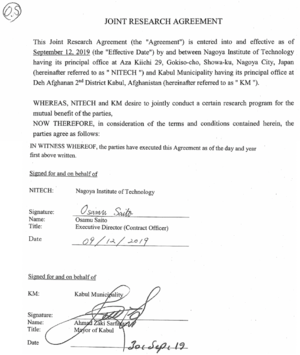
In 2019, the Nagoya Institute of Technology and Kabul Municipality agreed to use a digital platform called D-Agree. This platform helps people participate in city planning and reach agreements.
From September 2019 until August 2021, D-Agree was used for over 300 city planning discussions. More than 15,000 citizens took part and shared over 71,000 opinions. Even after the Taliban took over, D-Agree continues to help with urban planning.
In 2022, the United Nations reported that D-Agree Afghanistan is used as a digital solution for smart cities in Afghanistan. D-Agree uses artificial intelligence to help organize discussions. It helps classify sentences into issues, ideas, pros, and cons.
Learning in Kabul: Education
The Ministry of Education is in charge of Afghanistan's education system. Public and private schools in Kabul reopened after 2002. Boys and girls were encouraged to attend school. The Ministry of Education plans to build more schools to provide education for everyone.
High schools in Kabul include:
- Abdul Hadi Dawi High School
- Abdul Rahim-e-Shaheed High School
- Afghan Turk High Schools
- Aisha-i-Durani School
- Amani High School (founded 1924)
- Habibia High School (founded 1903)
- International School of Kabul
- Lycée Esteqlal (founded 1922)
- Malalai High School
Universities in Kabul
Kabul has many universities:
- American University of Afghanistan
- Bakhtar University
- Kabul Education University of Rabbani
- Kabul Medical University
- Kabul Polytechnic University
- Kabul University
- Kardan University
- Kateb University
- Salam University
Famous People from Kabul
Politicians
- Sher Ali Khan (c. 1825 – 1879), former leader of Afghanistan
- Abdur Rahman Khan (1840s – 1901), leader of Afghanistan
- Amanullah Khan (1892–1960), leader of Afghanistan during the Independence War
- Mohammed Zahir Shah (1914–2007), the last king of Afghanistan
- Abdullah Abdullah (born 1960), former chief executive of Afghanistan
- Roya Rahmani (born 1978), Afghanistan's first female ambassador to the United States
Musicians
- Mohammad Hussain Sarahang (1924–1983), singer
- Ahmad Zahir (1946–1979), singer
- Farhad Darya (born 1962), singer
- Aryana Sayeed (born 1985), singer
Athletes
- Salim Durani (1934–2023), former cricketer
- Asghar Afghan (born 1987), retired cricketer and former captain
- Hamid Rahimi (born 1983), boxer
Actors
- Azita Ghanizada (born 1978 or 1979), American actress
- Leena Alam (born 1978), film actress
- Annet Mahendru (born 1985), Afghan-born American actress
Writers
- Khaled Hosseini (born 1965), Afghan-American novelist
- Homeira Qaderi (born 1980), writer
Journalists
- Mustafa Nayyem (born 1981), Afghan-Ukrainian journalist
- Farahnaz Forotan (born 1992), journalist
Sister Cities
Kabul has "sister city" relationships with other cities around the world:
 Ankara, Turkey (since 2003)
Ankara, Turkey (since 2003) Istanbul, Turkey (since 1992)
Istanbul, Turkey (since 1992) Kazan, Russia (since 2005)
Kazan, Russia (since 2005) Kansas City, Missouri, United States (since 2018)
Kansas City, Missouri, United States (since 2018) Omaha, Nebraska, United States (since 2003)
Omaha, Nebraska, United States (since 2003)
Images for kids
See also
 In Spanish: Kabul para niños
In Spanish: Kabul para niños


